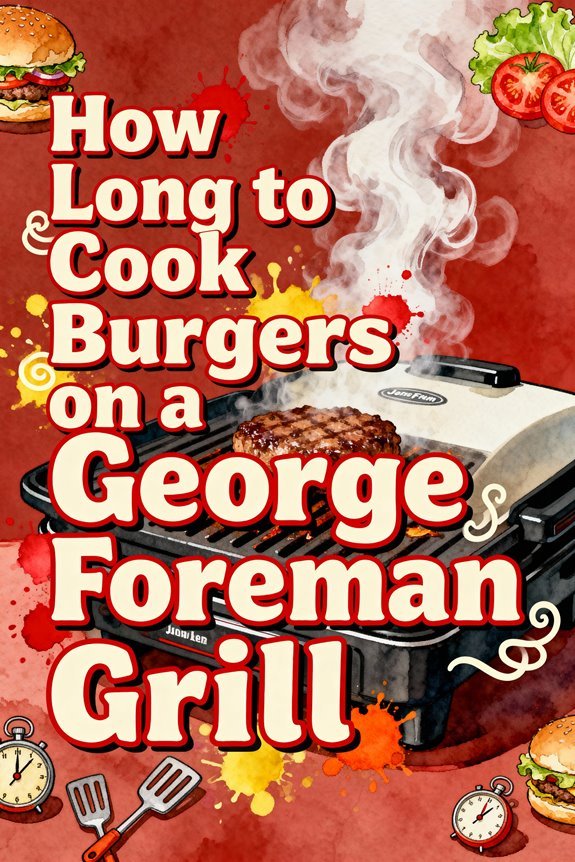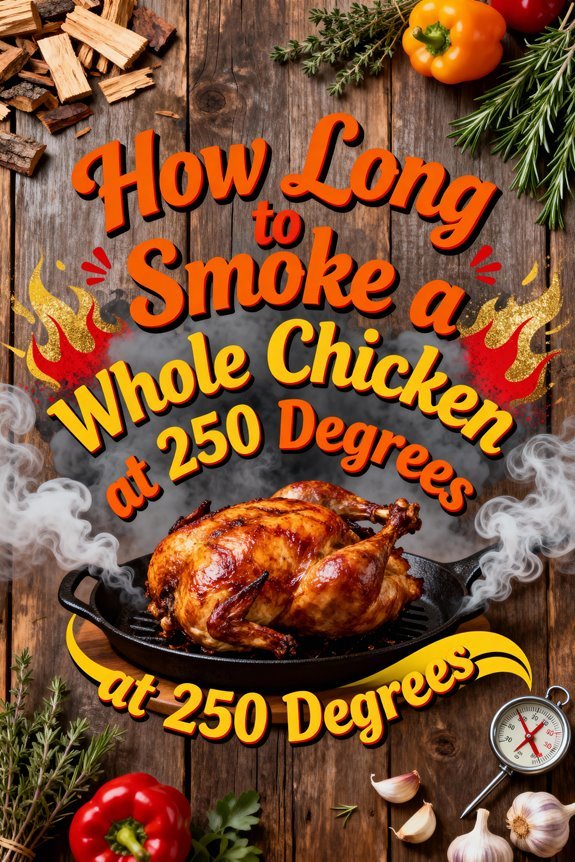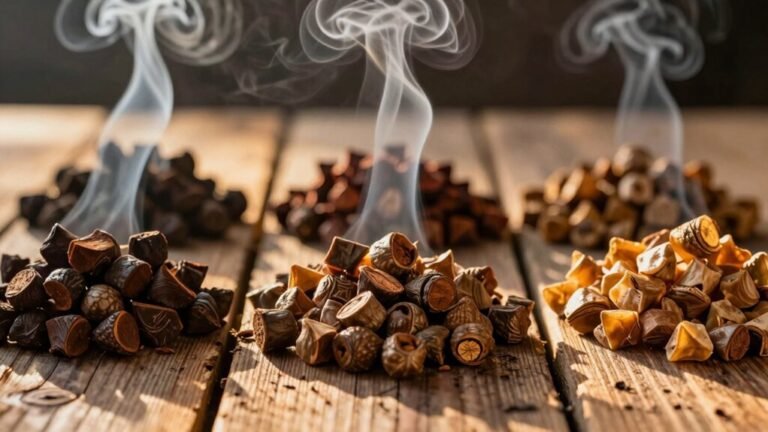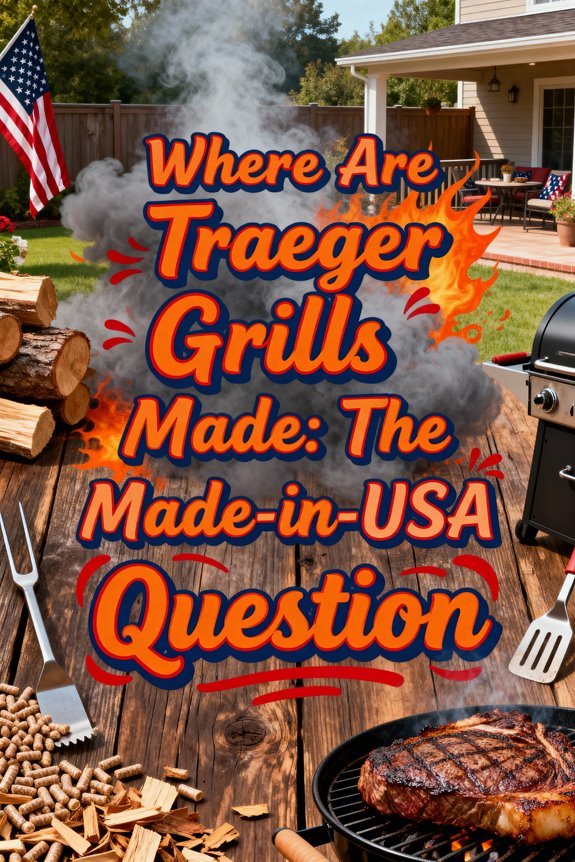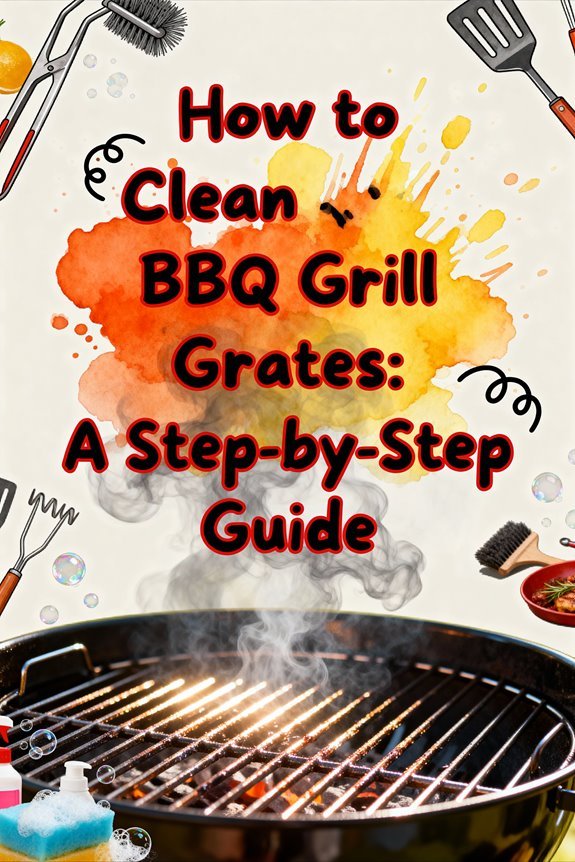To cook burgers on your George Foreman grill, preheat it to 425°F and adjust your cooking time based on patty thickness. Thin burgers (1/4 inch) need 3-4 minutes, standard patties (1/2 inch) take 4-7 minutes, and thick burgers (1 inch) require 8-10 minutes. For juicy results, avoid pressing down on the patties and let them rest for 3-5 minutes after cooking. The right temperature and technique will guarantee your burgers reach the perfect doneness level.
Perfect Cooking Times for Different Burger Thicknesses
When cooking burgers on a George Foreman Grill, the thickness of your patty directly determines its ideal cooking time. Very thin burgers (1/4 inch) need just 3-4 minutes, while standard 1/2-inch patties require 4-7 minutes depending on desired doneness. Your grill techniques should adjust accordingly as burger thickness increases. Using 80/20 ground beef creates the perfect balance of flavor and juiciness in your burgers.
For medium-thick patties (3/4 inch), plan on 6-8 minutes of cooking time, ensuring even pressure from the grill’s lid. Thick burgers measuring 1 inch or more need 8-10 minutes for thorough cooking. If you’re working with frozen patties, add 1-2 minutes to these baseline times. Remember to monitor internal temperatures carefully as thickness increases, and let thicker patties rest afterward to maintain juiciness. Create a small thumb indentation in the center of each patty before grilling to prevent them from puffing up during cooking. For optimal results, aim for a medium-high temperature of 375-400°F before placing your patties on the grill.
Getting Your Grill Ready: Essential Preheating Steps
Preparing your George Foreman Grill properly starts with essential preheating steps that guarantee perfect cooking performance. Begin your grill setup by wiping down the cooking plates with a damp cloth to remove any residue, and make sure the drip tray is securely positioned under the front of the unit. You’ll need to plug the grill into a standard 120V outlet and close the lid to activate the heating elements. Following proper preparation techniques, place the grill on a flat, clean counter surface before use. For optimal cleaning between uses, wait until the grill reaches ideal steam temperature of 400°F before wiping down the plates. Regular maintenance with a stainless steel sponge helps prevent grease buildup and ensures better-tasting food.
Watch for the indicator light to illuminate, signaling that the preheating process has begun. The grill typically takes 5-10 minutes to reach peak temperature. You’ll know it’s ready when the light turns off or changes color. During this time, remember to keep the lid closed and avoid touching hot surfaces. Use oven mitts when checking the grill’s status.
Temperature Guidelines for Your Desired Doneness
Getting your burgers cooked to the perfect doneness requires careful attention to temperature guidelines and timing. Understanding different doneness levels helps you achieve your ideal burger every time. For rare burgers, you’ll want to reach 120°F to 130°F, while medium rare falls between 130°F to 135°F. If you prefer medium, aim for 140°F to 145°F, and medium well should hit 150°F to 155°F. Well-done burgers need to reach at least 160°F. Since electric grills offer quick cook times, you can have perfectly cooked half-pound burgers ready in about 6 minutes. Similar to grilling chicken breasts, letting your burgers rest after cooking helps seal in the juices for optimal flavor. Like achieving the perfect golden crust on a grilled cheese sandwich, maintaining consistent heat is crucial for evenly cooked burgers.
Your cooking techniques should align with these temperatures. You’ll need 3-4 minutes per side for rare, 4-5 for medium rare, 5-6 for medium, 6-7 for medium well, and 7-8 for well done. Always use a meat thermometer to verify the internal temperature, as this guarantees both your desired doneness and food safety.
Tips for Shaping and Seasoning Your Burger Patties
Three essential steps form the foundation of perfect burger patties: proper shaping, precise seasoning, and careful meat selection. For consistent results, you’ll want to master various shaping techniques, from using a patty press to hand-forming with gentle pressure. Make your patties about ¾ to 1 inch thick, slightly larger than your bun to account for shrinkage. Use gentle pressing and folding to mix ingredients without overworking the meat.
When it comes to seasoning options, you can keep it simple with salt and pepper or experiment with pre-made burger blends. Season just before cooking to maintain ideal moisture. Choose 80/20 ground beef for the best flavor and juiciness, and keep the meat cold while handling. Don’t forget to create a slight dome in the center of your patties to prevent puffing, and chill them for at least an hour before grilling. For extra juiciness, try placing an ice cube in the center of each patty before cooking. For the juiciest results, aim for medium doneness at 145°F internal temperature.
Making the Best Cheeseburgers on Your Foreman
Creating mouthwatering cheeseburgers on your George Foreman Grill starts with proper temperature control and timing. Preheat your grill for 5 minutes until it reaches 425°F, guaranteeing even cooking and best searing. Cook your patties for 4-7 minutes depending on desired doneness, aiming for an internal temperature of 160°F. For optimal burger quality, use ground beef with 20% fat content to ensure juicy, flavorful results. Similar to cooking chicken breasts, using an instant-read thermometer helps guarantee perfectly cooked burgers every time. Just like with smoked chicken wings, achieving the right internal temperature is crucial for both safety and ideal texture.
Your cheese selection can range from classic American to specialty options like pepper jack or blue cheese. Add your chosen cheese during the final 30-60 seconds of cooking, leaving the lid open to prevent sticking. While the cheese melts, focus on bun toasting – spread butter on the cut sides and grill them for 2-3 minutes until golden brown. This two-step process guarantees perfectly melted cheese and crispy buns for the ideal burger experience.
Maintaining Juiciness While Grilling
While mastering cheese melting techniques enhances your burger’s flavor, maintaining juiciness throughout the grilling process will elevate your patties to perfection. For peak moisture retention, start with 80/20 ground beef and don’t overwork the meat when forming patties. Create a small indent in the center to guarantee even cooking. Following Minnesota’s famous recipe, sealing cheese inside creates an exceptionally moist burger. Just as with salmon preparation, patting the meat dry and seasoning before grilling helps achieve optimal results. Similar to proper freezing techniques, allowing burgers to cool completely before storing leftovers helps maintain their quality.
You’ll achieve the best results by preheating your Foreman grill to 425°F and cooking half-pound patties for 5-6 minutes for medium doneness. Don’t press down on the patties while cooking, as this forces out valuable juices. Once done, proper burger resting is vital – let your patties sit for 3-5 minutes to redistribute internal moisture. For extra juiciness, consider adding moisture-retaining ingredients like Worcestershire sauce or trying the Juicy Lucy style with cheese sealed inside.
Common Mistakes to Avoid When Grilling Burgers
Even experienced grill masters can fall prey to common burger-cooking mistakes that compromise flavor and texture. Avoid excessive flipping of your patties, as this disrupts the formation of a caramelized crust and leads to juice loss. Don’t press down on cooking burgers, which squeezes out precious moisture and causes the meat to stick to your grill. Using frozen store-bought patties can significantly impact the overall quality of your burgers. For optimal results when grilling frozen patties, two-zone grilling allows for more even cooking and better temperature control.
Consider patty size and burger shrinkage carefully – start with a 5½-inch patty for a 4-inch bun to maintain proper proportions after cooking. Monitor cooking temperature with a meat thermometer, aiming for 130-135°F for medium-rare, and exercise grilling patience to prevent overcooking. Moderate smoke flavor can be achieved by cooking burgers for about 30 minutes at the right temperature. Remember that less is more with seasoning balance; don’t overwhelm the natural meat flavors with too many toppings or excessive spices. These steps guarantee ideal juiciness retention and a superior burger experience.
Cleaning and Maintaining Your Grill for Perfect Results
To maintain your George Foreman grill’s ideal performance and longevity, proper cleaning after each use is essential. Start by letting your grill cool completely, then unplug it before beginning the cleaning process. Wipe down the plates with a damp cloth while they’re still warm but not hot to prevent stubborn residue buildup. Setting the temperature to level four provides optimal heat for most cooking needs. Deep cleaning sessions should be performed once or twice per season for best results.
For thorough maintenance, empty and clean the drip tray with warm, soapy water after each use. Don’t forget to check your grill accessories regularly for wear and tear. Using Bar Keepers Friend can help remove tough stains and buildup from your grill surfaces. You’ll want to avoid using abrasive cleaning tools that can damage the non-stick surface. Instead, use non-abrasive sponges and mild detergent for stubborn spots. Consider lining your drip tray with foil to simplify cleanup. The cleaning frequency should align with your usage – more frequent grilling requires more regular maintenance.
Safe Handling and Storage of Cooked Burgers
Once your burgers are perfectly cooked on your clean George Foreman grill, proper storage becomes the next key step in food safety. You’ll need to refrigerate your cooked burgers within two hours at 40°F (4°C) or below to prevent bacterial growth. Always check for signs of spoilage like unusual odors, slimy texture, or discoloration before consuming stored burgers. For safe storage, place them in airtight containers or wrap them tightly in foil, and they’ll keep for 3-4 days in your refrigerator. Just like cooked chicken storage, this timeframe ensures optimal food safety and quality. Using a vacuum sealer can help maintain freshness and extend storage time significantly.
If you’re planning to store them longer, you can freeze your cooked burgers for up to three months. Be sure to label containers with the storage date and always thaw frozen burgers in the refrigerator, never on the counter. When reheating, verify the internal temperature reaches 160°F (71°C) to maintain food safety standards and prevent foodborne illness.
Enhancing Flavors With Toppings and Seasonings
A perfectly cooked burger deserves thoughtful attention to toppings and seasonings that elevate its flavor profile. You’ll find endless topping combinations to enhance your burgers, from classic cheese varieties to caramelized onions and crispy bacon. Fresh herbs and pickle slices can add brightness and crunch to each bite. For optimal results, cook your burgers for 5-8 minutes on the grill. Similar to how internal temperature checks are crucial for perfectly cooked pork, using a meat thermometer ensures your burgers reach the right doneness. Just as resting time helps chicken thighs stay moist and tender, letting your burgers rest briefly after cooking allows the juices to redistribute.
When it comes to seasoning techniques, you’ll want to start with fundamental ingredients like garlic powder and Worcestershire sauce to build a savory base. Pre-mixed seasoning blends offer convenience, while smoked paprika can replicate that outdoor grilling taste. For Mediterranean-inspired burgers, try Italian seasoning with feta cheese and tzatziki sauce. Don’t forget to experiment with innovative combinations like stuffing cheese inside your patty for a Juicy Lucy or adding jalapeños for a spicy kick.

